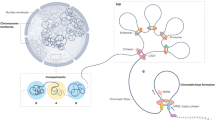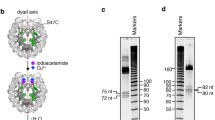Abstract
STEROID hormones accumulate in their respective target cells due to the presence of “receptor” proteins which bind the steroid with high affinity and specificity1–4. It seems that the steroid–receptor complexes then migrate and bind to nuclear chromatin2–5. Within about 15 min there is an alteration in transcription which is followed after 2 h by the appearance of specific messenger RNAs6–9. At present, the mechanism by which steroids alter gene expression is obscure. The group in our laboratory is attempting to identify the nuclear (or chromatin) component which binds the progesterone-receptor (P–R) complex because it is possible that the macromolecules involved are also involved in the steroid-induced modifications of gene expression. We have demonstrated recently more than one class of binding sites in chick oviduct nuclei in vivo and in hen oviduct nuclei and chromatin in vitro10–12,13. The highest affinity class of sites, representing 5,000–10,000 sites per cell nucleus, is suspected to be the biologically important class, because: (1) it is the only class which binds P–R in vitro in physiological ionic conditions (0.15–0.20 M KCl); (2) it is the only class bound in vivo when the steroid is at physiological levels in the serum; (3) binding to whole chromatin is tissue-specific, found only in oviduct chromatin, and (4) when these sites are saturated in vivo with the P–R, maximal responses of the RNA polymerase I and II activities are observed in vitro. Although additional nuclear binding to the sites of weaker affinity can be achieved in vivo, this causes no further alteration of polymerase activities13. We have also found that the low ionic conditions (0.01–0.05 M KCl), often used in binding assays, result in a pattern of nuclear binding which is non-saturable and shows no tissue specificity. When the ionic strength of the binding assays is increased to 0.15 M or 0.2 M KCl, there is a saturable, tissue-specific binding which measures selectively only the highest affinity class of binding sites10–12. We now present evidence which suggests that one fraction of the non-histone protein (NHP) (called AP3) is involved in the high affinity binding of P–R to the chromatin of the progesterone target tissue—oviduct—while other fractions (AP1 or AP2) are involved in masking these binding sites. We also present data which indicate that the high affinity binding sites are present but completely masked in non-target tissues.
This is a preview of subscription content, access via your institution
Access options
Subscribe to this journal
Receive 51 print issues and online access
$199.00 per year
only $3.90 per issue
Buy this article
- Purchase on Springer Link
- Instant access to full article PDF
Prices may be subject to local taxes which are calculated during checkout
Similar content being viewed by others
References
Raspe, G. (ed.), Advances in Biosciences, 7 (Pergamon, New York, 1971).
Spelsberg, T. C., in Acidic Proteins of the Nucleus (edit. by Cameron, I. L., and Jeter, P. R. Jr), 248–296 (Academic, New York, 1974).
Jensen, E. V., and DeSombre, E. R., A. Rev. Biochem., 41, 203–230 (1972).
O'Malley, B. W., and Means, A. R., Science, 183, 610–620 (1974).
Pasqualini, J. R. (ed.), Receptors and Mechanisms of Action of Steroid Hormones (Dekker, New York, 1976).
Glasser, S. R., Chytil, F., and Spelsberg, T. C., Biochem. J., 130, 947–957 (1972).
Chan, L., Means, A. R., and O'Malley, B. W., Proc. natn. Acad, Sci. U.S.A. 70, 1870–1874 (1973).
Cox, R. F., Haines, M. E., and Emtage, J. S., Eur. J. Biochem., 49, 225–236 (1974).
Schimke, R. T., McKnight, G. S., and Shapiro, D. J., in Biochemical Actions of Hormones, 3 (edit. by Litwack, G.), 245–269 (Academic, New York, 1975).
Spelsberg, T. C., Webster, R. A., and Pikler, G. M., in Chromosomal Proteins and Their Role in Gene Expression (edit. by Stein, G., and Kleinsmith, L.), 153–186 (Academic, New York, 1975).
Pikler, G. M., Webster, R. A., and Spelsberg, T. C., Biochem. J. (in the press).
Webster, R. A., Pikler, G. M., and Spelsberg, T. C., Biochem. J. (in the press).
Spelsberg, T. C., Biochem. J., (in the press).
Spelsberg, T. C., Steggles, A. W., and O'Malley, B. W., J. biol. Chem., 246, 4188–4197 (1974).
Spelsberg, T. C., Steggles, A. W., Chytil, F., and O'Malley, B. W., J. biol. Chem., 247, 1369–1374 (1972).
Chatkoff, M. L., and Julian, J. A., Biochem. biophys. Res. Commun., 51, 1015–1022 (1973).
Spelsberg, T. C., Steggles, A. W., and O'Malley, B. W., Biochim. biophys. Acta, 254, 129–134 (1971).
Lowry, O. H., Rosebrough, N. J., Farr, A. L., and Randall, R. J., J. biol. Chem., 193, 265–275 (1951).
Burton, K., Biochem. J., 62, 315–323 (1956).
Sober, H. A., Handbook of Biochemistry, 11–111 (Chemical Rubber Co. Cleveland, 1970).
Author information
Authors and Affiliations
Rights and permissions
About this article
Cite this article
SPELSBERG, T., WEBSTER, R. & PIKLER, G. Chromosomal proteins regulate steroid binding to chromatin. Nature 262, 65–67 (1976). https://doi.org/10.1038/262065a0
Received:
Accepted:
Issue Date:
DOI: https://doi.org/10.1038/262065a0
This article is cited by
Comments
By submitting a comment you agree to abide by our Terms and Community Guidelines. If you find something abusive or that does not comply with our terms or guidelines please flag it as inappropriate.



